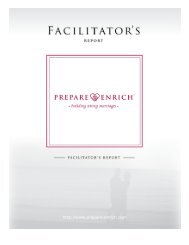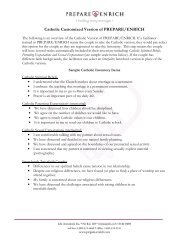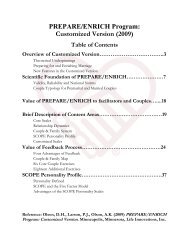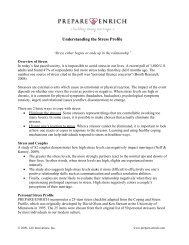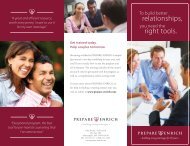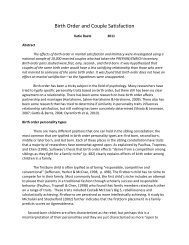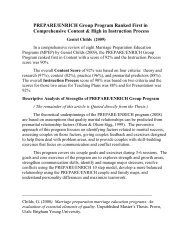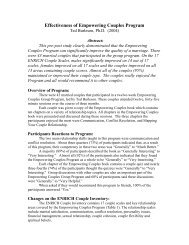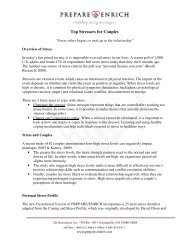Overview and New Discoveries about Couples - Prepare-Enrich
Overview and New Discoveries about Couples - Prepare-Enrich
Overview and New Discoveries about Couples - Prepare-Enrich
You also want an ePaper? Increase the reach of your titles
YUMPU automatically turns print PDFs into web optimized ePapers that Google loves.
1<br />
Journal of Family & Community Ministries, 2012, 25, 30-44.<br />
Also available: www.family<strong>and</strong>communityministries.org<br />
PREPARE-ENRICH Program: <strong>Overview</strong> <strong>and</strong> <strong>New</strong> <strong>Discoveries</strong> <strong>about</strong> <strong>Couples</strong><br />
David H. Olson, Amy K. Olson, Peter J. Larson<br />
Abstract<br />
This article highlights a variety of new discoveries made <strong>about</strong> premarital <strong>and</strong> married couples<br />
from data collected using the PREPARE-ENRICH assessment. A brief overview of the<br />
Customized Version is provided <strong>and</strong> evidence <strong>about</strong> its effectiveness when used with a couple or<br />
in a group setting. The Customized Version contains a variety of new scales that are producing<br />
compelling relationship findings in the areas of personality, cohabitation, stress, commitment,<br />
forgiveness, <strong>and</strong> spiritual beliefs. The authors provide practical information regarding the<br />
application of the program in faith group settings <strong>and</strong> in pastoral counseling.<br />
Introduction<br />
Over 3 million couples have participated in the PREPARE-ENRICH marriage program<br />
since it was developed 30 years ago. Data collected from participating couples has resulted in a<br />
large national <strong>and</strong> international database that provides unique research opportunities to make<br />
discoveries <strong>about</strong> premarital <strong>and</strong> married couples. This article provides a brief overview of the<br />
Customized Version of PREPARE-ENRICH (sixth edition of the assessment) <strong>and</strong> studies on the<br />
effectiveness of the program for helping couples build stronger relationships. The authors review<br />
recent discoveries based on the new scales in the Customized Version including the typology of<br />
couples, SCOPE personality scale, personal stress profile, cohabitation, commitment,<br />
forgiveness, <strong>and</strong> spiritual beliefs.<br />
More than 100,000 professionals (counselors <strong>and</strong> clergy) have been trained as facilitators<br />
in the PREPARE-ENRICH Program. Counselors include marital <strong>and</strong> family therapists,<br />
psychologists, social workers, <strong>and</strong> other counseling professionals. Clergy from all<br />
denominations, including military chaplains, have used <strong>and</strong> endorse the program as being highly<br />
relevant <strong>and</strong> user-friendly to learn <strong>and</strong> use with the couples. Also, couples are very pleased with<br />
the feedback <strong>and</strong> new information they gain <strong>about</strong> each other. They also learn relationship skills<br />
they can use to deal with current <strong>and</strong> future issues.<br />
Brief <strong>Overview</strong> of the Customized Version of PREPARE-ENRICH Program<br />
Widely known as a leading relationship inventory, PREPARE/ENRICH is called a<br />
“program” because it contains both a couples assessment <strong>and</strong> a semi-structured feedback<br />
process. As part of the feedback process, the program teaches the couple relevant relationship<br />
skills like communication <strong>and</strong> conflict resolution.<br />
The goal of the program is to help premarital couples prepare for marriage (PREPARE)<br />
<strong>and</strong> married couples enrich their marriage (ENRICH) by increasing their awareness of<br />
relationship strengths <strong>and</strong> growth areas <strong>and</strong> providing them with skills to improve their
elationship. The Customized version is totally online <strong>and</strong> is designed for dating, engaged, <strong>and</strong><br />
married couples. It is called Customized since it tailor-makes the assessment for each couple<br />
based on background information they provide.<br />
PREPARE/ENRICH has been scientifically developed <strong>and</strong> has high reliability, high<br />
validity, <strong>and</strong> large national norms with couples from various ethnic groups. Numerous studies<br />
demonstrate the rigor of the assessment <strong>and</strong> its relevance to couples from a variety of ethnic<br />
groups (Olson, 1998; Asai & Olson, 2004; Allen & Olson, 2001). Larson, Holman, Klein,<br />
Stahmann, <strong>and</strong> Peterson evaluated premarital assessment questionnaires <strong>and</strong> found PREPARE to<br />
be “most psychometrically sound” <strong>and</strong> rated it as “the best instrument for premarital counseling”<br />
(1995, p. 251). The program has been adopted by professional counselors from various fields<br />
(marital <strong>and</strong> family therapists, social workers, <strong>and</strong> psychologists) <strong>and</strong> clergy from many diverse<br />
religious groups.<br />
The Customized Version of PREPARE/ENRICH (Olson <strong>and</strong> Larson, 2008) is the sixth<br />
revision, <strong>and</strong> the distinctive feature of this online tool is its ability to dynamically adapt the<br />
content for each couple based on their relationship stage <strong>and</strong> family structure. In this way, the<br />
program is relevant for dating, engaged, or married couples.<br />
The core scales in PREPARE/ENRICH cover the topics of communication, conflict<br />
resolution, partner style <strong>and</strong> habits, financial management, leisure activities, affection <strong>and</strong><br />
sexuality, family <strong>and</strong> friends, relationship roles, <strong>and</strong> spiritual beliefs. Customized scales include<br />
topics such as cohabitation issues, cultural/ethnic issues, interfaith/interchurch, dating issues,<br />
forgiveness <strong>and</strong> a variety of scales for parenting based on the age of the child <strong>and</strong> parenting<br />
situations (parenting expectations, step-parenting, intergenerational issues, etc.). Beyond these<br />
core <strong>and</strong> customized scales, PREPARE/ENRICH assesses a couple’s closeness <strong>and</strong> flexibility,<br />
family-of-origin, personal stress, four areas of relationship dynamics, <strong>and</strong> five factors of<br />
personality. Finally, facilitators can select customized spiritual belief scales when working with<br />
couples from a variety of faith traditions (Protestant, Catholic, Jewish, etc.).<br />
During the feedback process, the facilitator receives a Facilitator’s Report (20-25 pages)<br />
<strong>and</strong> uses it to work with a couple. The couple is given their own Couple’s Report (10 pages)<br />
<strong>and</strong> Couple’s Workbook (25 pages) containing exercises covering the major topics from the<br />
assessment. The facilitator typically meets with a couple over 3-6 sessions <strong>and</strong> is trained to share<br />
the results of the assessment while teaching skills from the Couple’s Workbook. The goals <strong>and</strong><br />
core exercises of the program are to explore strength <strong>and</strong> growth areas, strengthen<br />
communication skills, identify <strong>and</strong> manage major stressors, resolve conflicts using a ten-step<br />
model, develop a more balanced relationship using the couple <strong>and</strong> family maps, <strong>and</strong> underst<strong>and</strong><br />
personality differences in order to maximize teamwork.<br />
The theoretical assumption <strong>and</strong> empirical finding is that the quality of the marital<br />
relationship can be predicted from the premarital relationship. In a predictive validity study using<br />
PREPARE, it was found that marital success (happily married vs. separated/divorced) three years<br />
into marriage could be predicted with 80-85% accuracy with PREPARE taken three months prior<br />
to the wedding (Fowers <strong>and</strong> Olson, 1986). This study was replicated by Larsen <strong>and</strong> Olson (1996)<br />
with another three year longitudinal sample of married couples.<br />
Therefore, it is possible to identify the relationship factors that, if improved, will make a<br />
difference to the quality of a marriage. This program applies four important characteristics of an<br />
effective preventative approach. First, factors which relate to marital success need to be<br />
identified. Second, couples need to be assessed on those critical variables. Third, feedback <strong>and</strong><br />
2
3<br />
exercises need to be given to couples, which will help them deal with problem areas. Fourth,<br />
couples need skill-building exercises focusing on communication <strong>and</strong> conflict resolution skills.<br />
An assessment <strong>and</strong> program which attempts to improve a couple’s relationship should<br />
obtain information on the most critical factors in premarital relationship development that are<br />
predictive of later marital satisfaction. In a comprehensive review of eight Marriage Preparation<br />
Education Programs (MPEP), Childs (2009) found the PREPARE/ENRICH program ranked first<br />
in terms of Content with a score of 92%. This overall Content Score was based on four criteria:<br />
theory <strong>and</strong> research (97%), context (82%), practice (96%), <strong>and</strong> premarital predictors (88%). In<br />
another study, Stahmann <strong>and</strong> Hiebert (1997) identified factors which relate to marital success. A<br />
diverse group of 238 clergy who did premarital counseling were asked to estimate the percentage<br />
of premarital couples experiencing problems or complaints in 29 possible areas. The five<br />
problem areas ranked as occurring most frequently were: communication (63%), unrealistic<br />
expectations of marriage or spouse (62%), money management/finances (60%), decision<br />
making/problem solving (55%), <strong>and</strong> power struggles (51%). All these topic have been<br />
systematically integrated into PREPARE/ENRICH.<br />
Effectiveness of Premarital Counseling with PREPARE-ENRICH<br />
Helping a couple prepare for marriage is a positive <strong>and</strong> effective experience for couples.<br />
Good premarital counseling helps the couple get their marriage off to a more positive start <strong>and</strong><br />
has been shown to reduce their chance of divorce by 30% (Stanley, 2001). Premarital counseling<br />
stimulates meaningful dialogue for the couple <strong>and</strong> teaches them communication <strong>and</strong> conflict<br />
resolution skills they can use to resolve current <strong>and</strong> future issues. <strong>Couples</strong> also learn the value of<br />
proactively working on their relationship <strong>and</strong> how they can maintain a healthy relationship.<br />
Whether done with an individual couple or in a group setting, recent studies have found that the<br />
PREPARE/ENRICH Program helps premarital couples get their relationships off to a great start.<br />
One study (Knutson & Olson, 2003) compared three levels of premarital programming;<br />
one group took the PREPARE/ENRICH assessment <strong>and</strong> had four feedback sessions (PE &<br />
Feedback), the second group only took the assessment (PE only), <strong>and</strong> the third group received<br />
neither (they did receive PE <strong>and</strong> feedback after the study). The PE Feedback group changed the<br />
most, with 8 of 10 areas significantly improving. The PE-only group improved in 3 of 10 areas<br />
<strong>and</strong> the control group made no changes. The PE & Feedback group had a 52% increase in the<br />
number of Vitalized couples (most happy couples) <strong>and</strong> an 83% decrease in the number of<br />
Conflicted couples (who are at high risk for divorce).<br />
Another study compared the PREPARE-ENRICH Program with an individual format<br />
versus a group format <strong>and</strong> found that both approaches were equally effective (Futris, Barton,<br />
Ahoulou, & Seponski, 2011). It was found that the couples in both approaches had positive<br />
gains in knowledge, felt more confident in their relationship, engaged in more positive conflict<br />
management behaviors, <strong>and</strong> were more satisfied with their relationship.<br />
Identifying & Building Couple Strengths<br />
There are several reasons why strengths are assessed <strong>and</strong> highlighted in PREPARE-<br />
ENRICH. Strengths are a foundation of a strong relationship. When couples experience stress,<br />
their strengths provide resources to help them cope with <strong>and</strong> manage their stress. Strengths also<br />
supply hope <strong>and</strong> contain overt or latent skills that can be utilized in weaker areas. Strengths are
4<br />
the building block for a healthy relationship <strong>and</strong> can be foundational in learning relationship<br />
skills.<br />
Strengths operate differently than “growth areas” across stages of a couple’s relationship.<br />
While premarital couples are most aware of their strengths <strong>and</strong> tend to minimize issues, married<br />
couple can readily list issues <strong>and</strong> have a harder time describing their strengths. Unhappy couples<br />
focus mainly on issues (growth areas) <strong>and</strong> have difficulty identifying any strengths. PREPARE-<br />
ENRICH assesses both strengths <strong>and</strong> growth areas, allowing a more balanced approach helping<br />
premarital couples become aware of potential issues <strong>and</strong> married couples remembering their<br />
strengths.<br />
Two major analyses with over 50,000 couples in each study were done to identify the<br />
strengths of happy couples as well as the common problematic issues (growth areas) with all<br />
married couples. The first was a national survey of 50,000 married couples (newlywed to over<br />
50 years) from all 50 states.<br />
The five areas most predictive of happy versus unhappy couples were (in rank order):<br />
communication, flexibility, closeness, personality compatibility, <strong>and</strong> conflict resolution. Happy<br />
couples had significantly higher scores (positive couple agreement) on these five areas compared<br />
to unhappy couples. More details on the results <strong>and</strong> other studies are on the website<br />
(www.prepare-enrich.com/research). Findings are also integrated into a self-help book called the<br />
Couple Checkup (Olson, Olson-Sigg, & Larson, 2008).<br />
The second national sample of over 50,000 consisted of couples who were creating a<br />
step-family <strong>and</strong> had taken PREPARE-ENRICH prior to remarriage with children. The five areas<br />
which were most predictive of happy remarried couples (in rank order) were: personality<br />
compatibility, communication, conflict resolution, leisure, <strong>and</strong> couple flexibility. Couple<br />
compatibility in leisure <strong>and</strong> was more important than couple closeness. Detailed results are<br />
summarized <strong>and</strong> integrated into a self-help book by Ron Deal <strong>and</strong> David Olson entitled the<br />
Remarriage Checkup (2010).<br />
Typology of Married <strong>Couples</strong><br />
Five distinct “types” (patterns) of couples was discovered when cluster analysis was used<br />
with a sample of 6,267 couples across ten core categories of PREPARE-ENRICH (Fowers &<br />
Olson, 1993). The five types of married couples range from those very high in marital<br />
satisfaction to very low: Vitalized, Harmonious, Conventional, Conflicted, <strong>and</strong> Devitalized.<br />
About 15-20% of the couples fell into each of these types. These types are very useful<br />
descriptive terms for groups of couples. Another useful aspect of the types is that other findings<br />
can be linked to these types. For example, the research shows that with the most happily type<br />
(Vitalized), there is very little spouse abuse, but abuse is very high in the Conflicted <strong>and</strong><br />
Devitalized types (Asai & Olson, 2003).
5<br />
Figure 1. Five Couple Types<br />
This couple typology has been replicated with African American (Allen & Olson, 2001)<br />
<strong>and</strong> Hispanic (Olson & Garrett, 2006) couples in the United States <strong>and</strong> it has also been replicated<br />
in other countries (Hong Kong, Japan, <strong>and</strong> Korea). What varies across the countries is the<br />
percentage of couples in the various types. For example, a higher percentage of married couples<br />
in Asian countries are “Harmonious” <strong>and</strong> “Conventional” when compared with the United States<br />
<strong>and</strong> other western cultures. This couple typology will be used in other parts of the paper to<br />
illustrate the findings as they relate to couples.<br />
Personality: Do Opposites Attack or Birds of a Feather Flock Together?<br />
The SCOPE Personality scale was created <strong>and</strong> integrated into the most recent<br />
(Customized) Version of PREPARE-ENRICH. SCOPE is based on the “Big Five” personality<br />
assessment that has been validated worldwide by psychologists (Costa & McCrae, 2003).<br />
SCOPE is an acronym for the five areas assessed: Social (introvert vs. extrovert), Change<br />
(openness to change vs. closed <strong>and</strong> conventional), Organized (orderly vs. flexible), Pleasing<br />
(agreeable vs. assertive), <strong>and</strong> Emotionally Stable (calm vs. reactive).<br />
In a recent study (Kaufman & Larson, 2011) of 10,000 married couples who took the<br />
PREPARE-ENRICH assessment, a cross-tabulation was done on each of the scales to examine<br />
whether people tend to marry those with similar or dissimilar personalities. SCOPE categorizes
6<br />
individuals into a high, average, or low score on each personality factor. In 60% of the cases,<br />
couples married someone quite different—one person scored in a higher range while the other<br />
was in a lower range. In <strong>about</strong> 20% of the cases, both persons had moderate scores, in 10% both<br />
had low scores, <strong>and</strong> the remaining 10% were both high.<br />
Further analysis was conducted to investigate whether similarities or differences in<br />
personality were related to couple satisfaction. In 80% of the couples, marital satisfaction was<br />
not related to similarity or differences in personality. However, in the 10% where both were high<br />
on the Emotionally Steady, Pleasing, or Organized scales, these were the happiest couples <strong>and</strong><br />
the 10% that were both low on these scales were the least happy.<br />
Stress in Premarital <strong>and</strong> Married <strong>Couples</strong><br />
The Personal Stress Profile is a new scale that has been integrated into the Customized<br />
Version. This scale contains 25 of the most frequently cited stressful issues based on research by<br />
David Olson <strong>and</strong> colleagues. Each person indicates how often each item is a stressor for them in<br />
the past year. An analysis was done by Larson & Olson (2009) with <strong>about</strong> 10,000 premarital<br />
couples <strong>and</strong> 10,000 married couples who took PREPARE-ENRICH in 2009.<br />
Significant differences were found in the top five stressors for premarital couples <strong>and</strong><br />
married couples. The top issue for premarital couples was “my job” <strong>and</strong> the top issue for<br />
married couples (<strong>and</strong> individually for both husb<strong>and</strong>s <strong>and</strong> wives) was “my partner.” Premarital<br />
couples also had stress <strong>about</strong> finances, cost of the wedding, lack of exercise, <strong>and</strong> sleep. Married<br />
couples were stressed <strong>about</strong> their job, feeling emotionally upset, inadequate income, <strong>and</strong> too<br />
much to do around the house. Husb<strong>and</strong>s <strong>and</strong> wives had similar top five issues, although they<br />
were in a slightly different order.<br />
Table 1. Top stressors reported by premarital <strong>and</strong> married couples.<br />
Premarital <strong>Couples</strong><br />
Your job<br />
Financial concerns<br />
Cost of wedding<br />
Lack of exercise<br />
Lack of sleep<br />
Married <strong>Couples</strong><br />
Your spouse<br />
Your job<br />
Feeling emotionally upset<br />
Inadequate income<br />
Too much to do around the home<br />
Cohabitation <strong>and</strong> Marital Success<br />
Over 7 million couples between the ages of 18 <strong>and</strong> 65 are currently cohabiting (U.S.<br />
Census Bureau, 2011). Earlier studies of cohabitation <strong>and</strong> divorce have indicated that cohabiting<br />
couples have higher divorce rates than non-cohabiting couples. However, more recent studies<br />
are finding that if the couple is engaged, the divorce rate is no different than non-cohabiting<br />
couples. This finding was replicated in a very comprehensive study of 20,000 couples by the<br />
Center for Disease Control (CDC, 2012).<br />
The relationship between cohabiting <strong>and</strong> dating status was investigated by Larson <strong>and</strong><br />
Olson (2010) using data from 35,684 couples who had taken PREPARE-ENRICH. Four groups<br />
of couples were created for the analysis: dating cohabiting, dating living apart, engaged<br />
cohabiting, <strong>and</strong> engaged living apart.
7<br />
For dating couples, living together is related to less robust <strong>and</strong> satisfying relationships.<br />
While 51% of the dating couples living apart were “Vitalized” (most happy type), only 21% of<br />
the dating couples cohabiting were “Vitalized.” Conversely, almost half (48%) of the cohabiting<br />
dating couples were “Conflicted” (most problematic type), while only 16% of non-cohabiting<br />
dating couples were “Conflicted.”<br />
For engaged couples, cohabiting did not make a large difference in the quality of their<br />
relationship. While there were more “Vitalized” couples that were non-cohabiting versus<br />
cohabiting (60% to 51%) <strong>and</strong> fewer “Conflicted” couples that were non-cohabiting versus<br />
cohabiting (5% to 13%), the differences were not large.<br />
The happiest couples are those that are engaged <strong>and</strong> not cohabiting, <strong>and</strong> the least happy<br />
are dating couples that are cohabiting. More specifically, while 60% of the engaged noncohabiting<br />
couples were “Vitalized” <strong>and</strong> only 5% were “Conflicted”, only 21% of the dating<br />
cohabiting couples were “Vitalized” <strong>and</strong> 48% were “Conflicted.”<br />
Table 2. Cohabitation <strong>and</strong> Couple Types<br />
Couple Type<br />
Dating<br />
Cohabiting<br />
(n=714)<br />
Dating<br />
Living Apart<br />
(n=2622)<br />
Engaged<br />
Cohabiting<br />
(n=14,309)<br />
Engaged<br />
Living Apart<br />
(n=18,039)<br />
Vitalized 21% 51% 51% 60%<br />
Harmonious 10% 4% 16% 6%<br />
Conventional 21% 29% 20% 29%<br />
Conflicted 48% 16% 13% 5%<br />
Commitment <strong>and</strong> Forgiveness<br />
The CDC study found that commitment is an important concept that helped to explain the<br />
findings on cohabitation. Commitment <strong>and</strong> forgiveness are two new scales added to the<br />
Customized Version of PREPARE-ENRICH. Commitment is assessed by four questions related<br />
to commitment to their partner. Forgiveness is a new 10-item scale that assesses whether a<br />
partner has requested <strong>and</strong> was granted forgiveness. This scale was validated in a dissertation by<br />
Mouttet (2009), who found that it correlated well with other established scales of forgiveness.<br />
There is a very positive relationship between commitment <strong>and</strong> couple satisfaction. In a<br />
study of over 1,200 married couples that were “Vitalized” it was found that 95% of them had<br />
scores high on the commitment scale. Conversely, in a sample of over 2,000 “Devitalized”<br />
married couples, only 23% of them scored high on commitment <strong>and</strong> 26% were in the low range<br />
(Larson & Olson, 2010). It is, of course, unclear whether high commitment leads to higher<br />
marital satisfaction or vice-versa.<br />
Forgiveness was found to be a very significant component in the relationship of happy<br />
couples. In a study of over 7,000 married couples, 87% of the Vitalized couples had high scores<br />
in forgiveness indicating it as a strength in their relationship. Conversely, Devitalized couples<br />
had low scores in forgiveness indicating this was a growth area in their relationship (Larson &<br />
Olson, 2010). An important part of feedback with PREPARE/ENRICH in working with<br />
Devitalized <strong>and</strong> Conflicted couples is to teach them effective ways to seek <strong>and</strong> grant forgiveness.
8<br />
Table 3. Forgiveness <strong>and</strong> Couple Types<br />
Growth Area Possible Possible Strength<br />
Growth Area Strength<br />
Vitalized 1% 3% 10% 87%<br />
Harmonious 5% 13% 31% 51%<br />
Conventional 19% 30% 29% 23%<br />
Conflicted 58% 28% 11% 3%<br />
Devitalized 87% 11% 2% 1%<br />
Spiritual Beliefs <strong>and</strong> Couple Satisfaction<br />
To better underst<strong>and</strong> the relationship between spiritual beliefs <strong>and</strong> marital satisfaction,<br />
Larson <strong>and</strong> Olson (2005) did a national survey of almost 24,671 couples. About half were<br />
Protestant, 15% Catholic, <strong>and</strong> the other 35% were from a range of Christian denominations.<br />
Unlike past studies that have used single item measures of beliefs <strong>and</strong> couple satisfaction, this<br />
study used 10-item scales for both areas.<br />
The greater the agreement between a couple on their spiritual beliefs, the more satisfied<br />
they are as a couple. Comparing couples high <strong>and</strong> low on agreement on spiritual beliefs, 36% of<br />
the high agreement couples were “Vitalized” (very happy), but only 5% of the low agreement<br />
couples were “Vitalized.” Conversely, 82% of the low agreement couples were “Conflicted”<br />
(unhappy) but only 9% of the high agreement couples were “Conflicted.” These are rather<br />
dramatic findings <strong>and</strong> it is, in part, because of the comprehensive <strong>and</strong> reliable nature of the<br />
spiritual beliefs scale <strong>and</strong> methodology in PREPARE/ENRICH.<br />
Premarital Counseling <strong>and</strong> Marital Counseling with PREPARE-ENRICH<br />
While PREPARE was originally designed for premarital counseling, ENRICH was<br />
created to be used with married couples. Now with the Customized Version, it tailor-makes the<br />
assessment for each couple based on the relationship status (dating, engaged, or married) <strong>and</strong><br />
other background <strong>and</strong> family factors (age, first marriage, children, etc.). Once the couple has<br />
taken the assessment, their facilitator receives an email notifying that the couple has completed<br />
their assessment <strong>and</strong> the results are ready to review, save, <strong>and</strong>/or print. There are three<br />
documents available to use with each couple: a Facilitator’s Report, a Couple’s Report, <strong>and</strong> a<br />
Couple’s Workbook with over 20 couple exercises to use in the feedback process. PREPARE-<br />
ENRICH is an important resource for clergy who are frequently called upon to provide pastoral<br />
care or counseling for couples in their congregation or community.<br />
Most counselors <strong>and</strong> clergy use PREPARE-ENRICH with an individual couple; however,<br />
there is also a Group Program that builds off of the main program. The group program can be<br />
used with couples at the same stage of the family life cycle (dating, engaged, or married) or they<br />
can be combined in the same cross-generational group—which is often a great learning<br />
experience for all couples. The program is easily adaptable to faith-based settings <strong>and</strong> can be<br />
incorporated in various types of weekly small groups.
9<br />
The PREPARE-ENRICH program is a valuable tool in assisting couples preparing for<br />
marriage <strong>and</strong> improving the quality of the marital relationship for couples at various life stages.<br />
Author Note: To be trained in PREPARE-ENRICH, the best approach is to go to a day training<br />
workshop. Over 500 workshops are offered nationally each year. A person can find one in their<br />
area by going to the website (www.prepare-enrich.com) <strong>and</strong> clicking on “Become a Trained<br />
Facilitator.” There is also a Self-Training approach with “Continuing Education” credits<br />
available as an option for mental health professionals. For more information <strong>about</strong> all aspects of<br />
PREPARE-ENRICH, go to the website: www.prepare-enrich.com.<br />
The authors all work at Life Innovations where the main product is PREPARE-ENRICH.<br />
Send correspondence to: dolson@prepare-enrich.com For more information on studies cited in<br />
this paper, go to: www.prepare-enrich.com/research<br />
*This paper is based on a plenary address presented by David Olson at the CAPS Annual<br />
Conference in Orl<strong>and</strong>o, Florida, on March 29, 2012. The collaboration of Peter Larson <strong>and</strong> Amy<br />
Olson on many of the PREPARE-ENRICH studies cited in this paper <strong>and</strong> their work on this<br />
paper is greatly appreciated.
10<br />
References<br />
Allen, W. D., & Olson, D. H. (2001). Five types of African-American couples. Journal of<br />
Marital <strong>and</strong> Family Therapy, 27, (3), 301-314.<br />
Asai, S. G., <strong>and</strong> Olson, D. H. (2003). Spouse abuse <strong>and</strong> marital system based on ENRICH.<br />
Unpublished manuscript. Retrieved from http://www.prepare-enrich.com/research<br />
Asai, S. G., <strong>and</strong> Olson, D. H. (2004). Culturally sensitive adaptation of PREPARE with<br />
Japanese premarital couples. Journal of Marital <strong>and</strong> Family Therapy, 30, (4), 411-426.<br />
Center for Disease Control – CDC (2012). First Marriages in the United States. National Health<br />
Statistics Report, 49, March 22, 1-22.<br />
Childs, G. (2008). Marriage preparation marriage education programs: An evaluation of<br />
essential elements of quality. (Unpublished master’s thesis). Brigham Young University,<br />
Provo, UT.<br />
Costa, P. T., & McCrae, R. R. (2003). Five factor model of personality. Lutz, FL: Psychological<br />
Assessment Resources, Inc.<br />
Deal, R.L., & Olson, D.H. (2010). The Remarriage Checkup. Minneapolis, MN: Bethany House.<br />
Fowers, B. J., & Olson, D. H. (1986). Predicting marital success with PREPARE: A predictive<br />
validity study. Journal of Marital <strong>and</strong> Family Therapy, 12, (4), 403-413.<br />
Fowers, B. J., & Olson, D. H. (1993). Five types of married couples based on ENRICH. The<br />
Family Journal, 1, (3), 196-207.<br />
Futris, T. G., Allen, W. B., Aholou, T. M., & Seponski, D. M. (2011) The impact of PREPARE<br />
on engaged couples: Variations by delivery. Journal of <strong>Couples</strong> <strong>and</strong> Relationship<br />
Therapy, 10, 69-86.<br />
Kaufman, A., & Larson, P. J. (2011). Personality & marital satisfaction. Unpublished<br />
manuscript. Retrieved from http://www.prepare-enrich.com/research<br />
Knutson, L. & Olson, D.H. (2003). Effectiveness of PREPARE program with premarital couples<br />
in a community setting. Marriage & Family Journal, 6, (4), 529-546.<br />
Larsen, A. S., & Olson, D. H. (1996). Predicting marital satisfaction with PREPARE: A<br />
replication study. Journal of Marital <strong>and</strong> Family Therapy, 15, (3), 311-322.<br />
Larson, J. H., Holman, T. B., Klein, D. M., Stahmann, R. F., & Peterson, D. (1995). A review of<br />
comprehensive questionnaires used in premarital education <strong>and</strong> counseling. Family<br />
Relations, 44, 245-252.<br />
Larson, P. J., & Olson, D. H. (2010). Cohabitation <strong>and</strong> relationship quality in dating <strong>and</strong><br />
engaged couples. Unpublished manuscript. Retrieved from<br />
http://www.prepare-enrich.com/research<br />
Larson, P. J., & Olson, D. H. (2010). Commitment in marriage. Unpublished manuscript.<br />
Retrieved from http://www.prepare-enrich.com/research<br />
Larson P. J., & Olson, D. H. (2010). Forgiveness in marriage. Unpublished manuscript.<br />
Retrieved from www.prepare-enrich.com/research<br />
Larson, P. J., & Olson, D. H. (2005). Spiritual beliefs <strong>and</strong> marriage: A national survey based on<br />
ENRICH. The Family Psychologist, 20, (2), 4-8.<br />
Mouttet, K. L. R. (2009) A comparative analysis of three scales intended to measure forgiveness.<br />
(Unpublished doctoral dissertation). Regent University, Virginia Beach, VA.<br />
Olson, D. H. (1998) PREPARE/ENRICH counselor’s manual: Version 2000. Minneapolis, MN:<br />
Life Innovations, Inc.
11<br />
Olson, D. H., & Garrett, J. (2006). Hispanic <strong>and</strong> Caucasian couples have similar couple types.<br />
Unpublished manuscript. Retrieved from http://www.prepare-enrich.com/research<br />
Olson, D. H., & Larson, P.J. (2009) The customized version of PREPARE/ENRICH.<br />
Minneapolis, MN: Life Innovations, Inc.<br />
Olson, D.H., Olson-Sigg, A., & Larson, P.J. (2008) The couple checkup. Nashville, TN: Thomas<br />
Nelson.<br />
Stahmann, R. F., & Heibert, W. J. (1997). Premarital <strong>and</strong> remarital counseling. San Francisco:<br />
Jossey-Bass.<br />
Stanley, S. M. (2001). Making a case for premarital education. Family Relations, 50, 272-280.<br />
U.S. Census Bureau. (2011). Statistical abstracts of the United States. www.census.gov




